Tristanita Minor: A Hidden Gem in the South Atlantic
Tristanita Minor is a remote and mysterious island located in the South Atlantic Ocean. Frequently overshadowed by its larger and more well-known neighbor, Tristan da Cunha, this lesser-known island remains one of the most secluded and least explored places on Earth. Shrouded in mist, myth, and natural beauty, Tristanita Minor has captivated the imagination of historians, biologists, and adventurers for centuries.
Geographical Location and Origin
Tristanita Minor is situated approximately 200 kilometers southeast of Tristan da Cunha and nearly equidistant between the southern tip of Africa and South America. Its geographic coordinates place it in one of the most isolated parts of the world, far from major shipping routes or populated continents. As part of the Tristan da Cunha archipelago, the island is a component of a volcanic chain formed over the Tristan hotspot—an area of volcanic activity stemming from deep within the Earth’s mantle.
Volcanic in origin, Tristanita Minor is the exposed peak of a deeply submerged seamount. Though smaller than Raoul Island of the Kermadec Islands, it boasts a dramatic and rugged landscape molded by millennia of geologic upheaval. Towering cliffs, basalt columns, and steep crater ridges define its topography, rising to a peak of 367 meters at Mount Obscura, its dormant volcanic summit.
Climate and Biodiversity
The climate on Tristanita Minor is classified as cool oceanic, heavily influenced by the surrounding South Atlantic currents. Average temperatures range from 8°C to 17°C throughout the year, with an annual rainfall exceeding 1,800 mm. Frequent fog and high winds are common, lending the island an eerie and ethereal ambiance for much of the year.
Despite its size and climatic harshness, Tristanita Minor supports a surprisingly rich array of flora and fauna. The island’s isolation has encouraged the evolution of several endemic species of plants and insects, while its cliffs and plateaus provide critical nesting grounds for numerous seabirds including petrels, shearwaters, and the Tristan albatross. It has been designated as an Important Bird Area (IBA) by BirdLife International.
Marine biodiversity in the surrounding waters is equally impressive. The cold nutrient-rich waters attract dolphins, seals, and seasonal visits from humpback and southern right whales. Kelp forests line the submerged rocky coast, offering habitat to a variety of fish and invertebrate species rarely seen elsewhere.
Human Presence and Accessibility
Unlike its sister island Tristan da Cunha, which maintains a small permanent settlement, Tristanita Minor has never supported a permanent population. Its challenging terrain, lack of freshwater sources, and unpredictable weather make long-term habitation impractical. Periodic visits by researchers and conservationists have been the only consistent human contact in recent decades.
Access to Tristanita Minor is highly restricted. The island is part of the British Overseas Territory of Saint Helena, Ascension and Tristan da Cunha, and any attempt to land requires approval from the territory’s administrator. Travel is only possible by charter vessel, with the nearest port of departure located over 2,400 kilometers away in Cape Town, South Africa. Those who journey here typically do so for scientific or environmental purposes, such as monitoring bird populations, studying volcanic activity, or removing invasive plant species.
Points of Interest and Curiosities
One of the most intriguing aspects of Tristanita Minor is its “Whispering Cliffs” — a series of wind-sculpted rock faces along the northern shore. Under certain wind conditions, the air moving through fissures creates low-frequency sounds that have been likened to whispers or chants. Early mariners who passed near the island recounted tales of being haunted by the island’s mournful cries.
Another point of curiosity is the presence of a strange rock formation known locally as the “Obsidian Sentinel.” This 12-meter tall column of jet-black volcanic glass stands at the southeastern end of the island, resembling a watchtower built by an ancient civilization. While scientists confirm it is a natural structure created by rapidly cooled lava interacting with seawater, its haunting visage has given rise to numerous theories about ancient visitors and lost knowledge.
Tristanita Minor also features several tide pools that support bioluminescent organisms. On moonless nights, these pools glow eerily, casting a supernatural halo over the rocky shorelines. This phenomenon has become a favorite subject for photographers lucky enough to document their rare visit.
Legends and Folklore
Legends surrounding Tristanita Minor have been passed down among seafarers for generations. The most famous of these is the legend of the “Isle of the Unseen.” According to maritime lore, the island appears only to those who are “unburdened by the world,” vanishing from sight for ships with engines or other modern technologies. This tale likely grew from the island’s propensity to be shrouded in thick mist, making it nearly invisible at sea level under certain light and weather conditions.
Another popular legend involves the “Watcher of the West,” a spectral figure said to appear along the island’s western headland during solstices. Described as tall, hooded, and holding a staff of whale bone, the Watcher is believed by some to be the guardian of the island, protecting its secrets from exploitation. While no concrete evidence supports the existence of such an apparition, multiple sightings have been logged in ship logs dating back to the early 1800s.
There is also a local myth about an “underground sanctuary” hidden within the dormant volcanic caldera. Allegedly, ancient navigators from a vanished civilization stored their sacred knowledge in obsidian tablets sealed in chambers beneath the mountain. To date, no expedition has verified the existence of this sanctuary, but rumors persist, fueled by accidental finds of unusual, carved stones and shards along the caldera’s rim.
Conclusion
Tristanita Minor remains one of the last true mysteries of the South Atlantic. With its striking landscapes, unique ecosystem, and rich tapestry of myth and legend, it continues to draw a quiet but passionate interest from explorers, scientists, and storytellers alike. Guarded by the sea and the elements, this hidden island offers a rare glimpse into a world untouched by time—an enigmatic sanctuary resistant to the pressures of the modern age.



